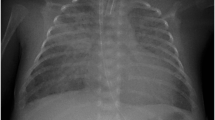Abstract
Various echocardiographic parameters are determined in the assessment and evaluation of a patent ductus arteriosus. In isolation, many of these parameters have a low sensitivity and specificity for ductal hemodynamic significance compared with ductal size. This study aimed to correlate various echocardiographic parameters with ductal size (transductal diameter) in infants with a symptomatic patent ductus arteriosus and to ascertain the accuracy of various parameters in predicting a duct 3 mm in size or larger. In this retrospective study, preterm infants younger than 32 weeks gestation who were evaluated for the presence of a patent ductus arteriosus during the period June 2010–2012 were assessed. The following echocardiographic parameters were measured: transductal diameter (TDD), ductal velocity, end-diastolic left pulmonary artery flow, ductal diameter-to-left pulmonary artery ratio (TDD:LPA), left atrial-to-aortic root ratio (LA:Ao), left ventricular output-to-superior vena cava flow ratio (LVO:SVC), transmitral E:A ratio, and isovolumic relaxation time (IVRT). The study enrolled 52 infants with a mean gestation age of 26 ± 2 weeks and a mean birth weight of 837 ± 240 g. The mean transductal diameter was 2.8 ± 0.5 mm. Transductal diameter correlated significantly with ductal velocity, end-diastolic LPA flow, TDD:LPA ratio, LA:Ao ratio, and LVO:SVC ratio but not with transmitral indices. The LVO:SVC ratio had the highest specificity (0.83) and sensitivity (0.95) for detecting a duct 3 mm in size or larger, the area under the curve being 0.95 (95 % confidence interval [CI], 0.85–0.99). Significant correlations between ductal size and surrogate markers of pulmonary overcirculation were noted.


Similar content being viewed by others
References
Condò M, Evans N, Bellù R, Kluckow M (2012) Echocardiographic assessment of ductal significance: retrospective comparison of two methods. Arch Dis Child Fetal Neonatal Ed 97:F35–F38
Davies MW, Betheras FR, Swaminathan M (2000) A preliminary study of the application of the transductal velocity ratio for assessing persistent ductus arteriosus. Arch Dis Child Fetal Neonatal Ed 82:F195–F199
El Hajjar M, Vaksmann G, Rakza T et al (2005) Severity of the ductal shunt: a comparison of different markers. Arch Dis Child Fetal Neonatal Ed 90:F419–F422
Hirashi S, Horiguchi Y, Misawa H et al (1987) Noninvasive Doppler echocardiographic evaluation of shunt flow haemodynamics of the ductus arteriosus. Circulation 75:1146–1153
Hirsimaki H, Kero P, Wanne O (1990) Doppler ultrasound and clinical evaluation in detection and grading of patent ductus arteriosus in neonates. Crit Care Med 18:490–493
Johnson GL, Breart GL, Gewitz MH et al (1983) Echocardiographic characteristics of premature infants with patent ductus arteriosus. Pediatrics 72:864–871
Khositseth A, Nuntnarumit P, Chongkongkiat P (2012) Echocardiographic parameters of patent ductus arteriosus in preterm infants. Indian Pediatr 48:773–778
Kluckow M, Evans N (1995) Early echocardiographic prediction of symptomatic patent ductus arteriosus in preterm infants undergoing mechanical ventilation. J Pediatr 127:774–779
Kozak-Barany A, Jokinen E, Kero P et al (2004) Impaired left ventricular diastolic function in newborn infants of mothers with pregestational or gestational diabetes with good glycemic control. Early Hum Dev 77:13–22
McNamara PJ, Sehgal A (2007) Towards rational management of the patent ductus arteriosus: the need for disease staging. Arch Dis Child Fetal Neonatal Ed 92:F424–F427
McNamara PJ, Stewart L, Sandesh S, Sehgal A, Stephens D, Redington A (2010) PDA ligation is associated with postoperative myocardial dysfunction in premature infants. J Thorac Cardiovasc Surg 140:150–157
Ramos FG, Rosenfeld CR, Roy L, Koch J, Ramaciotti C (2010) Echocardiographic predictors of symptomatic patent ductus arteriosus in extremely low-birth-weight preterm neonates. J Perinatol 30:535–539
Schmitz L, Stiller B, Koch H et al (2004) Diastolic left ventricular function in preterm infants with a patent ductus arteriosus: a serial Doppler echocardiography study. Early Hum Dev 76:91–100
Sehgal A, McNamara PJ (2009) Does echocardiography facilitate determination of hemodynamic significance attributable to the ductus arteriosus. Eur J Pediatr 168:907–914
Sehgal A, McNamara PJ (2012) Coronary artery perfusion and myocardial performance after patent ductus arteriosus ligation. J Thorac Cardiovasc Surg 143:1271–1278
Sehgal A, Paul E, Menahem S (2012) Functional echocardiography in staging for ductal disease severity: role in predicting outcomes. Eur J Pediatr [Epub ahead of print] 11 October
Silverman NH, Lewis AB, Heymann MA et al (1974) Echocardiographic assessment of ductus arteriosus shunt in premature infants. Circulation 50:821–825
Su BH, Peng CT, Tsai CH (1991) Echocardiographic flow pattern of patent ductus arteriosus: a guide to indomethacin treatment in premature infants. Arch Dis Child Fetal Neonatal Ed 81:F197–F200
Van Overmeire B, Chemtob S (2005) The pharmacologic closure of the patent ductus arteriosus. Semin Fetal Neonatal Med 10:177–184
Conflict of interest
Funding or financial relationship: None
Author information
Authors and Affiliations
Corresponding author
Rights and permissions
About this article
Cite this article
Sehgal, A., Menahem, S. Interparametric Correlation Between Echocardiographic Markers in Preterm Infants With Patent Ductus Arteriosus. Pediatr Cardiol 34, 1212–1217 (2013). https://doi.org/10.1007/s00246-013-0640-5
Received:
Accepted:
Published:
Issue Date:
DOI: https://doi.org/10.1007/s00246-013-0640-5




